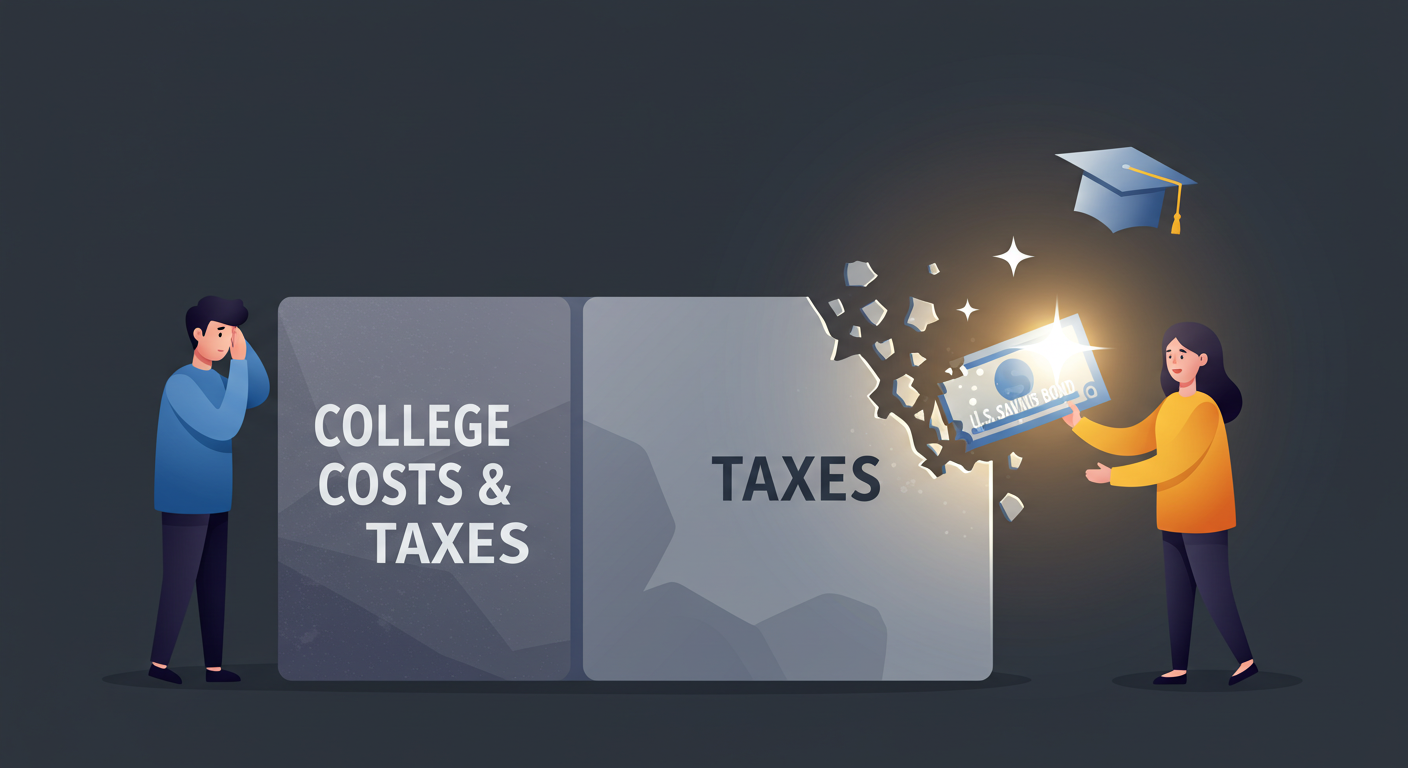College Planning Edition Episode 10 - Savings Bond Tax Breaks for Education (Series EE & I Explained + Form 8815)
YouTube
Spotify
Resources

Show Notes
Save for School, Save on Taxes: Your Guide to the Education Savings Bond Program
(Based on the Safe Simple Sound Podcast - College Planning Edition)
Funding education – whether for your children, grandchildren, or even your own future studies – feels like climbing a mountain for many families. The costs are daunting, and finding smart ways to save is crucial. But what if you could save and potentially reduce your tax bill at the same time?
That's where the U.S. Education Savings Bond Program comes in. It's a specific government initiative designed to help ease the financial burden of education by offering a potential tax break on the interest earned from certain savings bonds.
Here at Safe Simple Sound, we believe in making finance Safe, Simple, and Sound, empowering you to Seize Financial Control and Understand Financial Choices. This guide, inspired by our podcast discussion, breaks down the Education Savings Bond Program step-by-step. We'll cover:
- The Basics: What is this program and its core benefit?
- Eligibility: Who qualifies, which bonds work, and what are the income limits?
- Spending Smart: What expenses and schools count?
- Claiming Your Benefit: How is the tax break calculated, and what forms do you need?
Let's demystify this potentially valuable tool and see if it fits into your family's education savings plan.
The Basics: What is the Education Savings Bond Program?
At its heart, the program allows you to use specific U.S. Savings Bonds for Education (we'll detail which ones soon) and potentially avoid paying federal income tax on the interest those bonds earned.
The key benefit is called the Savings Bond Interest Exclusion. Normally, when you cash in U.S. savings bonds, the interest earned is subject to federal income tax. However, if you meet the program's requirements and use the bond proceeds (principal and interest) to pay for qualified education expenses, you might be able to exclude that interest income from your federal tax return.
Think of it this way:
- You save money using a safe government bond.
- The money earns interest over time.
- When you use that money for qualified education costs, the interest earned could be tax-free at the federal level. (State taxes may still apply).
This highlights the program's dual goal: 'Save for School, Save on Taxes.' It's not just a savings vehicle; it's a potentially tax-efficient strategy designed specifically for education funding.
Food for Thought: When considering different ways to save for college (like 529 plans or regular savings accounts), how important is the tax-saving aspect to your overall strategy? Does the idea of potentially tax-free interest make savings bonds more attractive?
Are YOU Eligible? Qualifying Rules for People & Bonds
This program sounds great, but eligibility is key. Like many government benefits, there are specific rules for both the taxpayer and the bonds themselves. You need a 'yes' on all these points to potentially qualify for the Savings Bond Interest Exclusion.
1. Who Can Claim the Tax Break?
You, the taxpayer filing the return, must be the one paying the qualified education expenses. These expenses must be for:
- Yourself
- Your spouse
- A dependent you claim on your tax return
Example: Paying tuition for your dependent child qualifies. Paying for your own graduate degree qualifies. Paying for a niece or nephew you don't claim as a dependent generally does not qualify for this specific tax break.
2. The Crucial MAGI Limit (Income Restriction)
This is a big one. Your ability to claim the exclusion depends on your Modified Adjusted Gross Income (MAGI). There are income phase-out ranges, meaning the benefit gradually reduces and then disappears as your income increases.
For Tax Year 2024:
- Single, Head of Household, Qualifying Surviving Spouse: The phase-out range is $96,800 to $111,800. If your MAGI is below $96,800, you might get the full exclusion (if other rules are met). If it's above $111,800, you cannot claim the exclusion.
- Married Filing Jointly: The phase-out range is $145,200 to $175,200. If your MAGI is below $145,200, you might get the full exclusion. If it's above $175,200, you cannot claim the exclusion.
Important: These MAGI limits are adjusted for inflation annually. Always check the limits for the specific tax year you plan to claim the exclusion.
3. Filing Status Rule
You cannot claim this exclusion if your tax filing status is 'Married Filing Separately'. Other statuses (Single, Married Filing Jointly, Head of Household, etc.) are generally okay if you meet all other criteria.
4. Qualifying Bond Types
Not just any savings bond works. Only these two types qualify:
- Series EE U.S. Savings Bonds issued AFTER 1989. (Bonds issued in 1990 or later).
- All Series I U.S. Savings Bonds.
Older Series EE bonds (issued 1989 or earlier) are not eligible for this specific education tax exclusion.
5. Ownership & Age Rule
This is about who owns the bond and how old they were when it was issued:
- Ownership: The qualifying bonds must be registered in your name alone, OR in both your name and your spouse's name (co-owners). Bonds registered only in your child's name, even if they are your dependent, generally won't qualify for you to claim the exclusion.
- Age: You (the owner, or at least one co-owner if married) must have been at least 24 years old before the bond's issue date. This rule aims to ensure the bonds were purchased by an adult intending to save for education.
Action Step: Review your estimated MAGI for the current year. Do you fall below or within the phase-out range? If you own Series EE or I bonds, check the issue dates (are EE bonds post-1989?), registration (is it in your name +/- spouse?), and your age when they were issued. This helps determine your potential eligibility.
Spending Smart: Qualified Expenses & Eligible Institutions
Okay, you're eligible, and you have the right bonds. Now, what can you actually spend the money on? The rules are specific here too.
Qualified Education Expenses
For this program, qualified expenses primarily include:
- Tuition and fees REQUIRED for enrollment or attendance at an eligible educational institution.
What's generally NOT qualified for this program:
- Room and board
- Student activity fees (unless mandatory for enrollment)
- Books and supplies (unless required fees include them)
- Insurance, transportation
- Expenses for non-degree courses (sports, games, hobbies, unless part of the degree program)
Think About It: How does excluding room and board impact how much of your total college costs this program could cover? While tuition is significant, this exclusion means the program likely won't cover the entire cost of attendance for many students.
Eligible Educational Institutions
This definition is broader and usually less restrictive. An eligible institution is generally any accredited postsecondary school eligible to participate in federal student aid programs. This includes most:
- Colleges and Universities
- Community Colleges
- Vocational and Technical Schools
If the school participates in programs like federal Pell Grants or federal student loans, it's almost certainly eligible.
Matching Funds and Record Keeping
Crucially, you need to be able to show that you used the bond proceeds (principal + interest) to pay for these specific qualified expenses at an eligible institution in the same year you claim the tax exclusion. Good record-keeping is essential! Keep track of:
- Which bonds you cashed and when.
- The total proceeds received (principal and interest breakdown, usually found on Form 1099-INT).
- Your qualified education expense payments (tuition bills, receipts).
Interaction with Other Education Benefits
If you claim other education tax benefits like the American Opportunity Tax Credit (AOTC) or the Lifetime Learning Credit (LLC) for certain expenses, you generally can't use those same expenses to qualify for the Savings Bond Interest Exclusion. The IRS prevents "double-dipping." This means your qualified expenses for the bond program might be reduced if you also claim these credits.
Action Step: List your anticipated future education costs. Circle those likely qualifying as tuition and required fees under this program's rules. This gives you a realistic picture of the program's potential impact.
Claiming Your Benefit: Calculation & Tax Filing
You've saved the bonds, paid the bills, and kept good records. How do you actually claim the tax break?
1. Calculate Adjusted Qualified Education Expenses (AQEE)
This is your starting point.
AQEE = Total Qualified Expenses - Tax-Free Educational Assistance - Expenses Used for Other Credits
- Total Qualified Expenses: Tuition & required fees paid.
- Tax-Free Educational Assistance: Pell Grants, tax-free scholarships, veteran's assistance, employer assistance, etc.
- Expenses Used for Other Credits: Expenses you used to figure the AOTC or LLC.
Your AQEE is the amount of qualified expenses you covered with funds not already receiving a tax break or covered by tax-free aid.
2. Calculate the Excludable Amount
Compare your Total Bond Proceeds (principal + interest from cashed qualified bonds) to your AQEE:
-
If Total Bond Proceeds ≤ AQEE: All the interest earned on those bonds may be excludable, subject to the MAGI limits.
-
If Total Bond Proceeds > AQEE: You can only exclude part of the interest. Use this formula:
Excludable Interest = Total Bond Interest * (AQEE / Total Bond Proceeds)Example: You cash bonds getting $9,000 total ($6k principal, $3k interest). Your AQEE is $7,650. Since $9,000 > $7,650, you use the formula:
$3,000 Interest * ($7,650 AQEE / $9,000 Proceeds) = $2,550
In this case, $2,550 of the interest is potentially excludable.
3. Apply the MAGI Limit
Crucial Step: After calculating your potential exclusion (full or partial), you MUST check it against the MAGI limit phase-out for your filing status and the tax year. If your MAGI falls within the phase-out range, your calculated exclusion will be reduced. If your MAGI is above the range, your exclusion is zero, regardless of your expenses or bond redemption.
4. File the Right Tax Form
To claim the exclusion, you must file IRS Form 8815, Exclusion of Interest From Series EE and I U.S. Savings Bonds Issued After 1989, with your Form 1040 federal tax return. This form walks you through the calculations, including the MAGI reduction if applicable.
The final amount of excluded interest is then reported on Schedule B (Form 1040), Interest and Ordinary Dividends.
Action Step: Search online for "IRS Form 8815". Look at the form to familiarize yourself with the information needed. Think about how you'll track bond redemptions and qualified expenses throughout the year to make tax time easier.
Key Takeaways: Is This Program Right for You?
The Education Savings Bond Program can be a valuable tool, but it's not automatic. Remember the key checks:
- Eligibility: Do you meet the owner, age, dependent, and filing status rules?
- Bonds: Do you have the right type (Series EE post-'89 or Series I) and were they issued correctly?
- MAGI Limits: Is your income within the eligible range for the tax year? (This is often the biggest hurdle).
- Expenses: Are you paying qualified expenses (mainly tuition/fees) at an eligible institution?
- Calculation & Filing: Are you prepared to calculate the exclusion and file Form 8815?
If the stars align, this program offers a fantastic way to make your education savings work harder by potentially eliminating the federal tax drag on interest earnings.
Take the Next Step
Navigating education funding and tax rules can feel complex. Understanding tools like the Education Savings Bond Program is one piece of building a sound financial plan.
If you have questions about how this program might fit into your specific situation, need help evaluating your eligibility, or want to discuss broader college savings strategies, we're here to help.
Let's talk about making your financial plan Safe, Simple, and Sound.
Contact Safe Simple Sound Today!
We hope this guide has helped clarify the Education Savings Bond Program. Keep learning, keep planning, and keep building that secure future!


